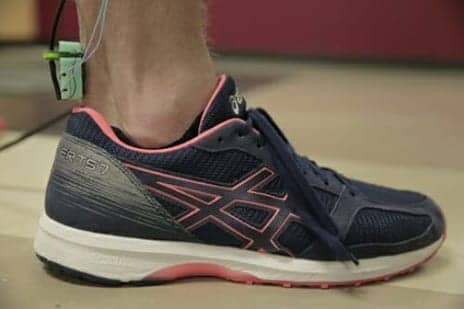
A team of University of Wisconsin-Madison engineers has designed a device that can be placed over the Achilles tendon and measure one’s postinjury tendon fitness. (Photo courtesy of Renee Meiller)
Engineers from University of Wisconson-Madison have developed a device to noninvasively measure tendon tension while the wearer is walking or running.
The device, which is placed over the Achilles tendon, is designed to assess the forces transmitted by the tendons, to determine the wearer’s fitness after undergoing physical therapy due to an injury.
Muscles generate movement at joints by pulling on tendons. But assessing the forces transmitted by tendons inside the body of a living person is tricky, explain the researchers, in a media release.
“Currently, wearables can measure our movement, but do not provide information on the muscle forces that generate the movement,” says UW-Madison mechanical engineering professor Darryl Thelen, whose work, published recently in Nature Communications, is supported by the National Institutes of Health.
Placement of the device on the skin over a tendon enables Thelen, as well as his graduate student Jack Martin, to assess tendon force by looking at how the vibrational characteristics of the tendon change when it undergoes loading, as it does during movement.
This phenomenon is similar to a guitar string, where the tension in the string changes the vibrational response. When a guitar string is plucked, the speed of the wave traveling along the string, and thus the vibration frequency, is related to the tension, or force, applied to the string, the release continues.
“We’ve found a way to measure the vibrational characteristics—in this case, the speed of a shear wave traveling along a tendon—and then we went further and determined how we can interpret this measurement to find the tensile stress within the tendon,” he adds.
The portable system for measuring wave speed includes a mechanical device that lightly taps the tendon 50 times per second. Each tap initiates a wave in the tendon, and two miniature accelerometers determine how quickly it travels.
The researchers have used the device to measure forces on the Achilles tendon, as well as the patellar and hamstring tendons. In each case, they can measure what happens in the tendon when users modify their gait—for example, by changing step length or speed.
By measuring how muscles and tendons behave within the human body, this system could eventually enable clinicians to plan more effective treatments for patients suffering from musculoskeletal diseases and injuries, the researchers suggest in the release.
“We think the potential of this new technology is high, both from a basic science standpoint and for clinical applications,” Thelen continues. “For example, tendon force measures could be used to guide treatments of individuals with gait disorders. It may also be useful to objectively assess when a repaired tendon is sufficiently healed to function normally and allow a person to return to activity.”
[Source(s): University of Wisconsin-Madison, Science Daily]





